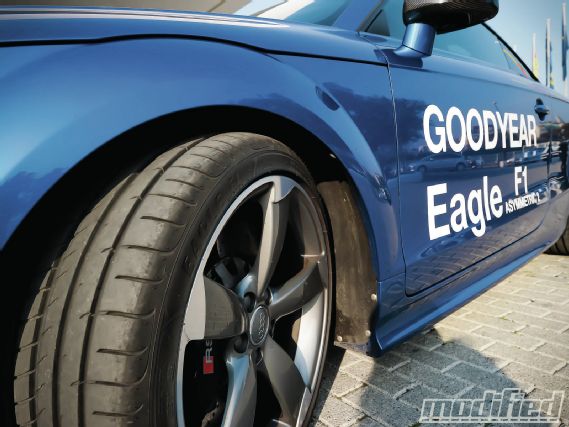 Goodyear Eagle F1 Asymmetric 2 - Tire Review
Goodyear Eagle F1 Asymmetric 2 - Tire Review
Specs & Details
Goodyear Eagle F1 Asymmetric 2
Type All-season performance radial
Size 225/35R19
UTQG 300
Key Features
- ActiveBraking Technology: Each tread block contours under higher-load braking situations, therefore increasing contact patch size
- Crossed-ply carcass structure for increased rigidity and drastically reduced weight
- High-surface silica tread compound to reduce heat generation
- FuelSaving Technology: Less material in the tire and less heat generation, leading to lower rolling resistance and increased fuel economy
Test Mule
’11 Audi TT RS & ’11 Audi A7 TDI
Test Driver Nate Hassler
Test Track Streets of Seville and Circuito Monteblanco, La Palma del Condado, Spain
Track Condition 70 degrees Fahrenheit, dry and wet test track
 |
Goodyear Eagle F1 Asymmetric 2 - Tire Review
|
Goodyear Eagle F1 Asymmetric 2 - Tire Review
Earlier this year, I was invited to attend a product release media event in the south of Spain; Goodyear Tire had a new passenger tire it was very excited about, and it didn’t take long me long to get booked and hop over the pond. No one knew what to expect going into this event — there were speculations aplenty — and what Goodyear delivered was above and beyond anyone’s expectations. The tire we were presented with is the new Eagle F1 Asymmetric 2, a completely redesigned successor to the widely liked original Asymmetric.
With a completely new tread compound, the Asymmetric 2 provides much better performance than what we normally expect from a 300 UTQG all-season tire. One of the interesting new features of this tire is what Goodyear calls ActiveBraking Technology. In a nutshell, the tread blocks on these tires are specially designed with a bit of a round, tapered edge. Under braking, load is transferred to whichever blocks are in contact with the pavement, and the tread blocks actually flatten themselves upon the road, creating a slight increase in contact patch over traditional non-contoured tread blocks.
Another feature that increases performance, as well as fuel economy, in the Eagle F1 Asymmetric 2 is the tire’s structural construction. Goodyear has designed an interwoven cross-sectioned carcass structure in its new tire, which is not only lighter and more rigid than traditional carcass construction but also maintains a surprising amount of comfort, despite the increased stiffness. Providing ample amounts of grip, the Audi TT RS test mules (if you can call them “mules”) felt incredibly well composed under “spirited driving conditions” through the pleasantly well-maintained Spanish back roads, and when time comes to sit back and cruise, there are no excessive amounts of road noise or other unpleasantries.
 |
Goodyear Eagle F1 Asymmetric 2 - Tire Review
|
Goodyear Eagle F1 Asymmetric 2 - Tire Review
In the larger and admittedly less-sporty Audi A7 TDI, the Asymmetric 2 was put to the test in wet conditions, and the results were pleasing yet again. With minimal hydroplaning and no experienced loss of traction, I think it’s safe to say that anyone who drives like a reasonable human being in the rain (as you should, the Asymmetric 2 isn’t a racing tire) will not feel uneasy or unsafe at any time due to the tire, even in heavy rainfall.
The end result is a very well balanced tire, ideal for use in either dry or wet conditions. Obviously, this tire isn’t intended for snow or icy weather. Anyone who lives in an area with inclement weather needs to have a set of dedicated summer and winter tires, and the Asymmetric 2 is a perfect candidate for the former.
